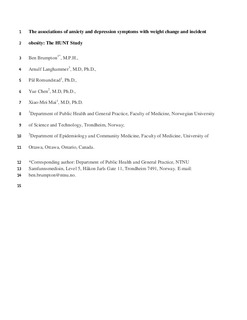| dc.contributor.author | Brumpton, Ben Michael | |
| dc.contributor.author | Langhammer, Arnulf | |
| dc.contributor.author | Romundstad, Pål Richard | |
| dc.contributor.author | Chen, Yue | |
| dc.contributor.author | Mai, Xiao-Mei | |
| dc.date.accessioned | 2017-06-12T07:36:13Z | |
| dc.date.available | 2017-06-12T07:36:13Z | |
| dc.date.created | 2013-01-11T15:39:38Z | |
| dc.date.issued | 2013 | |
| dc.identifier.citation | International Journal of Obesity. 2013, 37 (9), 1268-1274. | nb_NO |
| dc.identifier.issn | 0307-0565 | |
| dc.identifier.uri | http://hdl.handle.net/11250/2445702 | |
| dc.description.abstract | OBJECTIVE: To investigate the associations of anxiety and depression symptoms with weight change and incident obesity in men and women.
DESIGN: We conducted a prospective cohort study using the Norwegian Nord-Trøndelag Health Study (HUNT).
SUBJECTS: The study cohort included 25 180 men and women, 19–55 years of age from the second survey of the HUNT (1995–1997).
MEASUREMENTS: Anxiety and depression symptoms were measured using the Hospital Anxiety and Depression Scale. Weight change was determined for the study period of an average 11 years. Incident obesity was new-onset obesity classified as having a body mass index of greater than or equal to30.0 kg m2 at follow-up. The associations of anxiety or depression with weight change in kilograms (kg) was estimated using linear regression models. Risk ratios (RRs) for incident obesity associated with anxiety or depression were estimated using log-binomial regression.
RESULTS: In men, any anxiety or depression was associated with an average 0.81 kg (95% confidence interval (CI) 0.27–1.34) larger weight change after 11 years compared with those without such symptoms (mean weight change: 5.04 versus 4.24 kg). Women with any anxiety or depression had an average 0.98 kg (95% confidence interval (CI) 0.49–1.47) larger weight change compared with those without such symptoms (mean weight change: 5.02 versus 4.04 kg). Participants with any anxiety or depression had a significantly elevated cumulative incidence of obesity (men: RR 1.37, 95% CI 1.13–1.65; women: RR 1.18, 95% CI 1.00–1.40).
CONCLUSION: We found that symptoms of anxiety and depression were associated with larger weight change and an increased cumulative incidence of obesity in both men and women. | nb_NO |
| dc.language.iso | eng | nb_NO |
| dc.publisher | Nature Publishing Group | nb_NO |
| dc.title | The associations of anxiety and depression symptoms with weight change and incident obesity: The HUNT Study | nb_NO |
| dc.type | Journal article | nb_NO |
| dc.type | Peer reviewed | nb_NO |
| dc.description.version | acceptedVersion | nb_NO |
| dc.source.pagenumber | 1268-1274 | nb_NO |
| dc.source.volume | 37 | nb_NO |
| dc.source.journal | International Journal of Obesity | nb_NO |
| dc.source.issue | 9 | nb_NO |
| dc.identifier.doi | 10.1038/ijo.2012.204 | |
| dc.identifier.cristin | 986457 | |
| dc.description.localcode | © 2013 Macmillan Publishers Limited. This is the authors' accepted and refereed manuscript to the article. | nb_NO |
| cristin.unitcode | 194,65,20,0 | |
| cristin.unitname | Institutt for samfunnsmedisin | |
| cristin.ispublished | true | |
| cristin.fulltext | postprint | |
| cristin.qualitycode | 1 | |
